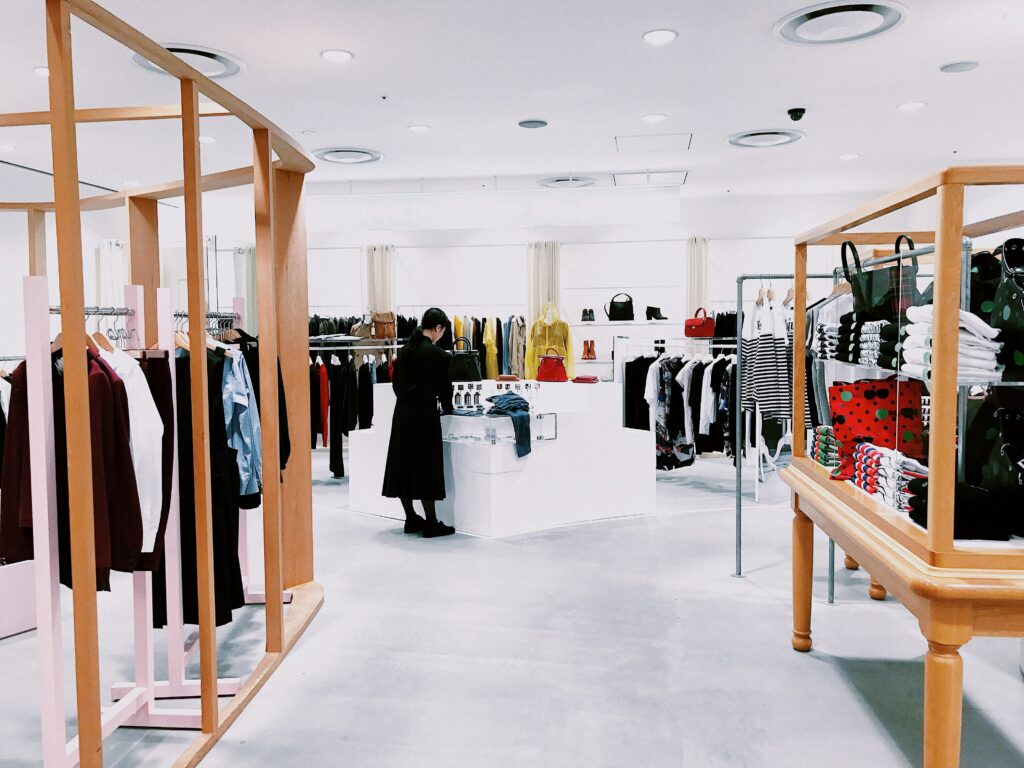All things being equal, creating a better shopping experience for your customers is likely to increase sales and improve long-term loyalty. It’s as true in-store as it is online! The big question is: what does “better” actually mean?
Improvement can only be measured against a standard, so let’s say we’re aiming to get more customers through the door, staying in the store, and buying products. An improvement to the in-store experience is any change that enables these goals without reducing overall profitability.
This is a crucial distinction because it directs our efforts towards changes that directly benefit the business, rather than giving customers an amazing experience…where they don’t actually buy anything.
So—what can you do to create a better in-store shopping experience that leads to tangible results for your store?
Catch eyes from outside
If your store benefits from heavy foot traffic, your first job in improving the in-store experience starts outside: you need to turn passers-by into shoppers!
Think about your signage, your windows, your colors and branding. Think about your target customer. What can you change to get their attention and entice them inside your store?
One idea is to physically go outside and walk the street. Pay attention to the stores that catch your eye, or which look the best. What are they doing right? How can you emulate them?
A re-painted storefront or eye-catching sign can produce a better ROI than thousands of dollars of ad spend.
Don’t try to be unique
“Be unique” is the kind of advice you’ll get from people who spend a lot of time online and have never actually run a business. You don’t want to be unique, you want to be effective—that’s why our first suggestion is to draw inspiration from successful companies around you.
Uniqueness can be interesting or captivating without ultimately benefiting the business. Worst case scenario, your cool and unique store will bring in heaps of the wrong type of shopper; ones that are never actually going to buy from you.
Remember, improving the customer experience also means increasing revenue or LTV. Don’t be unique for the sake of it.
Stunts like this one from NY&C in California are interesting and might pull people into the store…but if you’re not pulling in the right people, then what’s it for? You should instead invest time in being whatever your customers want you to be…
Learn from your customers
Making changes to impress your customers requires data. A lot of generic advice says “Include things to occupy kids!” or “host events in your store!” or “add social media to your store!”—but do your customers actually want any of this stuff?
Of course when we talk about data, it should be empirical. You’ve noticed that shoppers love being offered a cup of coffee. In fact, this usually leads to better conversations and a higher likelihood of making a sale—so you buy a good coffee machine and teach everyone to use it. This vastly improves the customer experience, but also brings value to the business.
You can take a more scientific approach. Have an employee stand by the door to ask customers on their way out, how was your shopping experience? You can do the same thing by sending a survey with their e-receipt. Try to get long-form answers and actually read them. What are people not liking? Can you improve it? What’s making a positive impact? Can you double-down?
Without knowing your business, it’s impossible to give extremely specific ideas for in-store improvements. But understanding what your customer wants—as a collective, if not every individual—empowers you to make specific and highly impactful changes. Build around your customers’ desires and you will enjoy greater success!
Empower your employees
While people are attracted by your products and fancy advertising, your employees are the heart and soul of your retail store. They influence customer experience and buying decisions more than any other factor, and in a variety of ways. Here are a few high-impact ways your employees can improve the customer experience.
Give them a reason to care
If your employees are straight up rude to customers, make a mess of your store, and have a major attitude problem, this article isn’t going to help you—there are deeper issues to resolve!
A more realistic problem for retailers is that staff are just working a job. They don’t really care and aren’t really invested in maximizing sales or creating memorable experiences for the customer: they want to work their hours and then get on with the rest of their lives.
But virtually everyone wants to enjoy their work and find it fulfilling. And when they do, their output transforms.
This is where incentive comes in; giving employees a reason (or better yet, a whole bunch of reasons) to work hard, engage customers, and develop their product knowledge.
And no, this doesn’t just come down to salary or threatening to fire them for doing a bad job! In the modern workplace, and especially since COVID-19 started, employees have started putting subjective factors—job satisfaction, opportunity, inclusion, community—ahead of pure financial incentive. You could try:
- Introducing shorter shifts. It’s easier for employees to put in maximum effort for shorter periods. (Of course, this isn’t always possible, but may be worth investigating)
- Tie promotion opportunities to customer feedback
- Offer training in salesmanship, customer service, or related skills. The more confidence someone has in performing a role, the more they’ll enjoy it and the better they’ll perform.
- Rewards like PTO for high-performing employees. (Try to rotate this around so everyone is incentivized. Paid time off is as effective for incentivizing as rewarding)
Train employees in your brand of selling
People love talking about how “hard selling” is a thing of the past, and that today’s salespeople are cool, fun, charismatic, and ultra-relaxed. They’re more like a friend than anything, and wouldn’t dream of asking for a sale!
And that’s fine, but it’s also naive. Companies rely on a vast array of different sales techniques and customer interaction styles, ranging from entirely passive to extremely direct. You know what works best in your store—i.e. what resonates most with your customers—so whatever that is, train your employees to deliver it!
As a rule, customers in a hardware store want concise answers and helpful information—nothing more, nothing less. I want to find the right product for the job and move on. Car buyers, however, generally want to be shown multiple options and hear the benefits of each. Whatever your customers’ expectations are, train your team to meet them! The result will be happier buyers, reduced friction and a greater likelihood of sales.
Give your employees product knowledge
Almost without exception, there is nothing like an extremely well-informed employee to make the buying process more streamlined and enjoyable. If I go into that hardware store and the staff member can advise me on a product and tell me exactly where to find it, I won’t be doing any more research or looking online. I’ll be buying the product there and then.
Conversely, when the employee doesn’t have any answers, it can get pretty frustrating. So give your new employees time (paid time) to really learn the products and ask questions of more experienced staff. The effect on the shopping experience will be worth it!
Can you add an experiential element?
This won’t work for every brand or store, but the ability to interact with the product—especially if it’s not usually possible—can be invaluable. Take the legendary Japanese knife maker, Ryusen Hamono. In 2019, he decided to open a novel store for his knife shop. Visitors could not only look at the knives and learn their characteristics, but also test their sharpness, balance, and feel for themselves.
This is a rare example of innovation. By letting shoppers use the knives, and experience their exceptional sharpness, workers at Ryusen Hamono need to sharpen them more often. However, the interaction makes the products much more compelling and lead to greater sales—and, importantly for the company, customers getting the best knife for their needs.
Car brands are also good examples. You can usually test drive for free, but you can also look around cars, jump into every seat, play with the controls etc. If you sell a product for which the feel, weight, touch is important, allowing customers to interact with the product could be huge for enticing them to buy.
Find sources of friction—and lubricate them!
Reducing purchase friction is extremely popular for online checkouts, but it’s something that’s too often neglected in physical stores.
An increasing number of retail stores use automated checkouts: customers scan their own products, pay, and leave. This means fewer staff members are needed to operate cash registers (saving space and giving staff a chance to do more impactful work—improving customer experience). It also ensures that queues are minimized during busy periods. But when it is busy, these same companies have iPads in a drawer which, with a few clicks, turn into instant cash registers!
This is just one way to keep queues (a high source of friction) minimal at any time of day.
Match your online presence (if established)
If you have a strong online presence and personality, bring that into the store (if it’s not there already).
Are you a lively, jokey, fun brand? Encourage that persona in your staff, your signage, and your ads. Do you position your brand as helpful to a fault? Teach staff to be inquisitive and helpful, always offering to go above and beyond. Are you direct and to the point? Approach customers and ask if they’re looking for something exact, or have a specific problem, then solve it for them—and then move on.
Whatever it is that online shoppers expect to find in your store, make sure it’s there!
Improving the in-store experience is fundamentally about finding ways to make your store more appealing to your customers—even if your products aren’t unique. By investing in your staff and making an effort to understand your customers, you should be able to make massive changes with minimal expense.
















